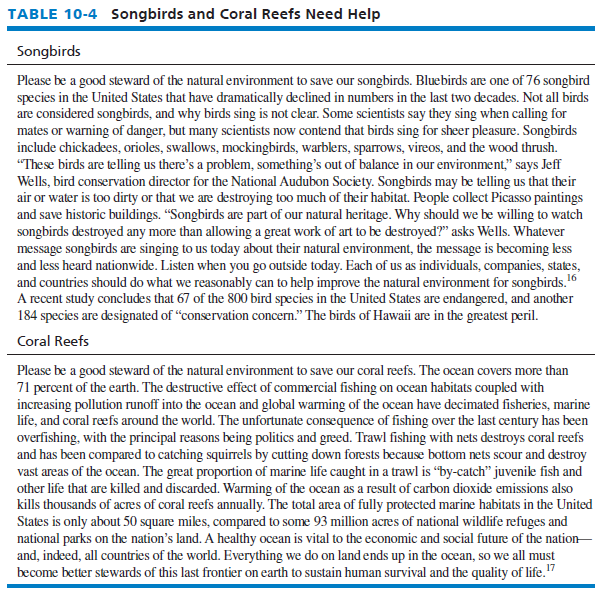Consumers globally are becoming increasingly intolerant of any business or nation that directly or indirectly destroys wildlife, especially endangered wildlife, such as tigers, elephants, whales, songbirds, and coral reefs. Affected businesses range from retailers that sell ivory chess pieces to restaurants that sell whale meat. The United States recently crushed over 6 tons of elephant ivory as part of a global effort to combat elephant poaching; one elephant is killed every 16 minutes.14 The Chinese government recently destroyed more than 6.1 tons of elephant ivory to help stop illegal ivory smuggling that is fueling poaching and decimating elephant populations in Africa. There are today less than 100,000 elephants in Africa, down from more than 300,000 in 2002, primarily because the demand for ivory remains robust in Asia, particularly China.
African giraffes are in danger of becoming extinct due to hunting and poaching in Africa that has decimated the giraffe population. There are only about 80,000 giraffes left in the wild, down from 140,000 giraffes 15 years ago. Fewer than 300 West African giraffes remain in Niger, and only 700 Rothschild’s giraffes remain in Uganda and Kenya. Poaching is especially detrimental in eastern and central Africa, partly because some people (in Tanzania) erroneously believe the giraffe’s meat and/or bone marrow is an HIV cure.
Many New Zealanders, supported by Australians, are outraged about Japan’s large-scale whaling operations in the antarctic. Japan recently issued permits allowing its whalers to kill up to 935 Antarctica minkes, 50 fin whales, and 50 humpbacks as part of “research into sustainable hunting.” Whale meat is regarded as a delicacy in Japan and can fetch up to US$38 for 100 grams. Japan ironically is a member of the International Whaling commission that has banned commercial whaling in a 31 million square-mile area around Antarctica known as the Southern ocean Whale Sanctuary. Unfortunately, South Korea recently resumed whaling, despite a 1986 moratorium on commercial whaling. Many countries are upset with whaling, including Australia, where the prime Minister Julia Gillard asserted, “We are completely opposed to whaling; there’s no excuse for scientific whaling.” Only a few countries—such as Norway, Japan, and Russia—favor and engage in commercial whaling. Norway was soundly criticized globally in mid-2015 for launching whalehunting expeditions, to follow up on their killing 729 whales the prior year, the most annual whale killings by Norway in two decades. countries, municipalities, and companies increasingly run the risk of being boycotted and exposed for direct or indirect wildlife endangering practices.
about 50 million sharks are killed every year solely to cut off (and sell) their fins.15 although “shark-finning” was outlawed in U.S. waters in 2000, the law does not ban fin imports or serving the fins in food, so about 57 metric tons of fins are imported in the United States annually. Only eight U.S. states have laws banning the sale of shark fins in food: Hawaii, Oregon, Washington, Illinois, California, Maryland, New York, and Delaware. The problem is much worse in some countries, especially China. More than 25 percent of the world’s shark species now face extinction, according to the International Union for Conservation of Nature.
Table 10-4 reveals the impact that bad environmental policies have on songbirds and coral reefs, two of nature’s many ecosystems.

Food Suppliers and Animal Welfare
Humane treatment of animals matters! Walmart, other retailers, and restaurants are demanding that food suppliers treat animals better, and consumers are flocking to organic foods. Thus, numerous food companies, such as Tyson Foods, the largest U.S. meatpacker, are phasing out use of human antibiotics and are “housing” animals more humanely. Walmart says its suppliers must begin to “raise animals with sufficient space for them to express normal behaviors and freedom from discomfort.” Walmart wants the use of battery cages for chickens, gestation crates for hogs, and veal crates for cows to be eliminated, although such small confined areas are currently used to raise many chickens, pigs, and cows in the United States. Wayne pacelle, cEo of the Humane Society of the United States, wants Walmart to set a timeline for compliance. parents want their children to eat food raised without use of growth hormones and antibiotics. Sales of organic milk, eggs, and other food products are booming, even at the higher prices. Walmart is by far the largest grocer in the United States, with grocery accounting for 56 percent of the company’s $288 billion in sales in 2014.18
Source: David Fred, David Forest (2016), Strategic Management: A Competitive Advantage Approach, Concepts and Cases, Pearson (16th Edition).

Why users still use to read news papers when in this technological world all is accessible on web?
What’s Going down i am new to this, I stumbled upon this I’ve discovered It absolutely helpful and it has helped
me out loads. I am hoping to contribute & aid other customers like
its helped me. Great job.
Hi, just wanted to say, I enjoyed this article. It was helpful.
Keep on posting!
Thanks for sharing your thoughts about website. Regards